Basic AI Chatbot Pricing: A simple chatbot that can answer questions about a product or service might cost around $10,000 to develop.
Read More

Ever feel like suddenly everyone’s launching the next-gen AI sports app... except you?
Spoiler: they probably are.
And they’re not doing it for fun. They’re doing it because AI is transforming the sports industry faster than you can say "instant replay."
From AI-driven coaching to real-time fan analytics, what used to take hours of manual crunching now happens in milliseconds, automatically, intelligently, and sometimes even while you’re still lacing up your sneakers.
And here's a stat to prove it's not just hype: The global AI in sports market size was estimated at USD 8,917.7 million in 2024 and is expected to grow at a CAGR of 21.1% from 2025 to 2030.
That’s not just growth. That’s a full-blown power play.
So whether you're a sports tech entrepreneur, a fitness startup founder, or someone who's tired of sitting on the AI sidelines, this is your sign. Your playbook.
Your how-to guide to build an AI sports app that doesn’t just keep up but dominates.
We’re diving deep into every phase of AI sports app development, from idea to execution, with insights that are clear, clever, and totally fluff-free.
Whether you're looking to develop an AI-powered sports application or exploring mobile application development with AI integration, you’re in the right arena.
Ready to create a sports app with AI that fans rave about and investors remember?
Let’s kick things off with why the sports world is obsessed with AI (and why you should be too).
Let’s get one thing straight, you don’t need to own a stadium to make a dent in the sports industry.
But you do need to be smart. And smart today means AI smart.
In an industry that lives on speed, accuracy, and experience, traditional tools are lagging behind.
Coaches still digging through video files?
Analysts buried in spreadsheets?
Fans refreshing scoreboards manually?
That’s so 2015.
This is exactly where AI app development for the sports industry steps in, with automation, precision, and personalization that humans simply can’t match (unless they have a photographic memory and sleep 3 minutes a night).
Here’s how AI is solving real problems across the sports ecosystem:
AI impact: Cuts hours of manual video review into instant, actionable feedback.
Injury prevention just got smarter.
AI impact: Coaches become data scientists, minus the spreadsheets and sleepless nights.
AI impact: Keeps fans hooked, boosts retention, and turns passive viewers into die-hard followers.
AI impact: Cuts production costs and delivers Netflix-style experiences to live events.
These capabilities are also at the heart of many enterprise AI solutions currently disrupting the sports and media industries.
AI impact: Say goodbye to gut-feel scouting and hello to data-driven talent acquisition.
AI impact: Reduces client churn, increases results, and automates trainer workloads.
AI impact: Makes casual players feel like seasoned analysts. And keeps them playing longer.
In short, the use cases are endless, and the ROI is very real.
Now, let’s explore the different types of AI sports apps you can build, because there’s no one-size-fits-all in this game.
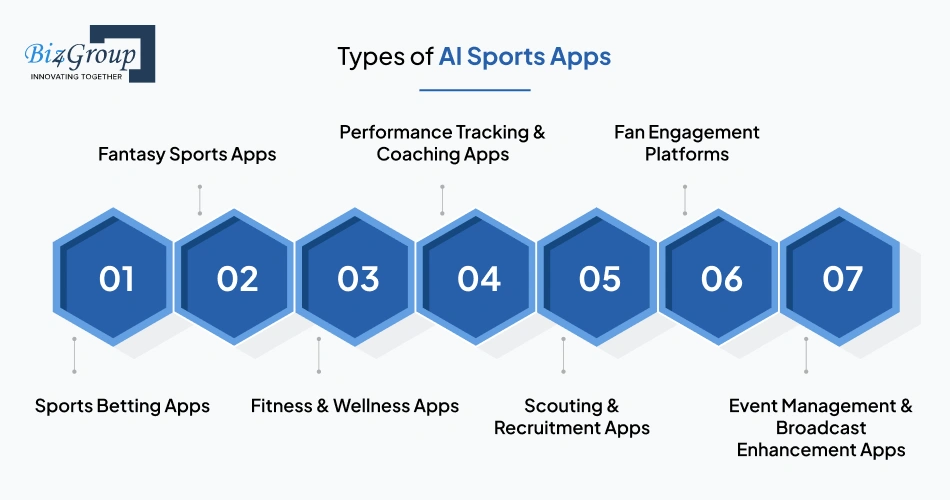
Think all sports apps are just scoreboards with push notifications? Not even close.
When you build an AI sports app, you’re designing an experience tailored for a very specific crowd: players, fans, coaches, analysts, broadcasters, and sometimes all of them at once. The good news? There’s room to innovate in every niche.
From hardcore scouting platforms to fan-first engagement apps, the types of AI-integrated sports apps you can develop are as diverse as the sports world itself.
Each serves a different purpose, and more importantly, a different opportunity for monetization and market impact.
Let’s break them down one by one, so you can find the perfect fit for your goals, and maybe even spark an idea you hadn’t considered yet.
Modern bettors demand:
This is where AI comes in—crunching real-time stats, team analytics, and market trends to keep the experience fluid, fair, and incredibly fast.
And if you’re thinking, “Sure, but that sounds hard to pull off,” well... that’s what we thought too, until we built SportsMEX.
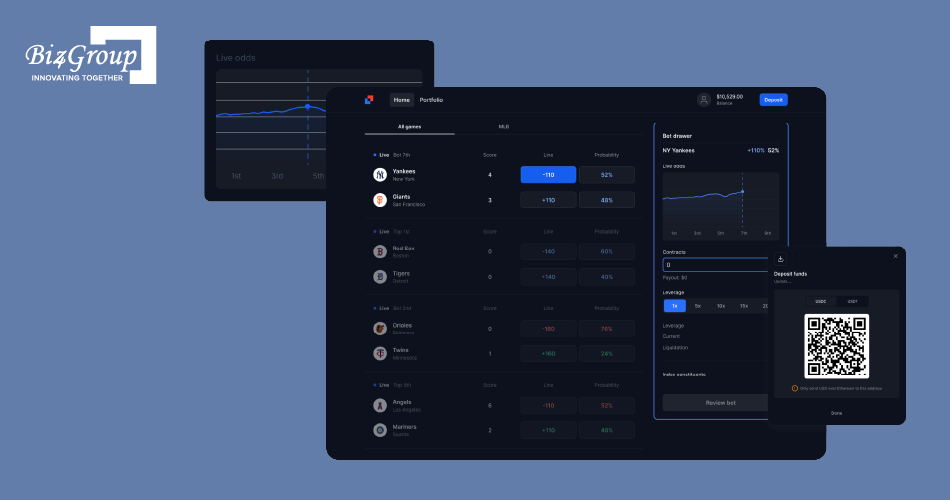
SportsMEX is a powerful, real-time sports betting platform designed for fans of MLB, CFB, and NFL across the globe.
Our goal? Deliver live odds and seamless user experiences even during peak game traffic.
What we faced:
What we delivered:
With SportsMEX, we didn’t just check the boxes, we rewrote the playbook for scalable, high-speed sports betting app development.
And if that’s the kind of build you're envisioning, you’re already talking to the right team.
Casual guesses? Out.
Data-driven picks? In.
Here’s how AI is reshaping fantasy sports:
Now imagine applying that same intelligence inside real teams, not just for fun, but for actual performance enhancement.
That’s where our next project comes in.
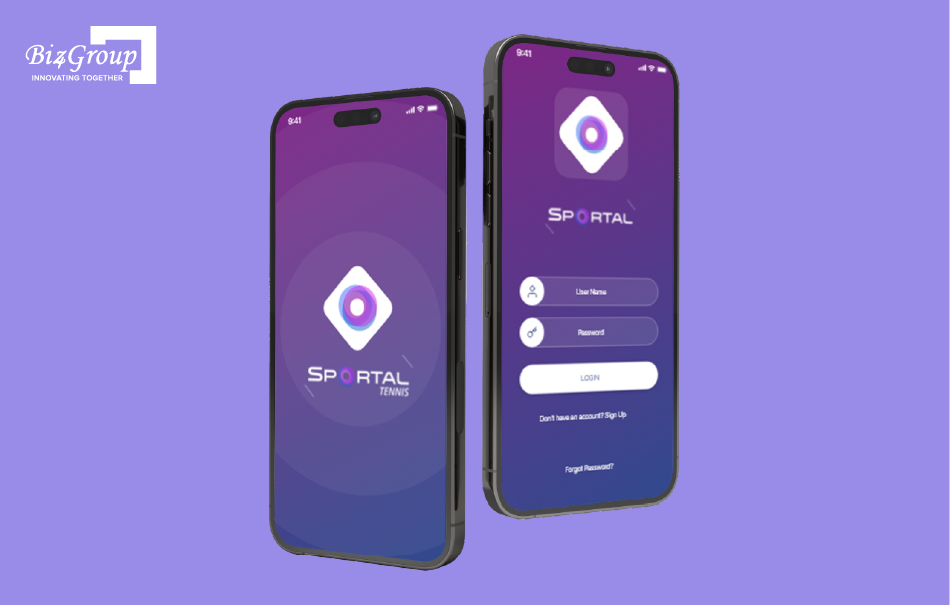
Sportal is a smart fantasy-style platform designed for real teams, giving coaches and athletes a digital edge in organizing, managing, and improving day-to-day performance—no spreadsheets, no guesswork.
What we faced:
What we delivered:
If you’re planning to launch your own platform, it helps to partner with a seasoned fantasy sports software development company (like us) that knows the space inside out.
With Sportal, we brought AI efficiency to grassroots performance management, making life easier for coaches and giving athletes a serious upgrade in how they train, track, and thrive.
Also read: AI Fantasy Sports App Development Guide
Here’s how AI is streamlining and upgrading fitness & wellness platforms:
And yes, we’ve done it. Meet the AI Workout App that redefines intelligent training.
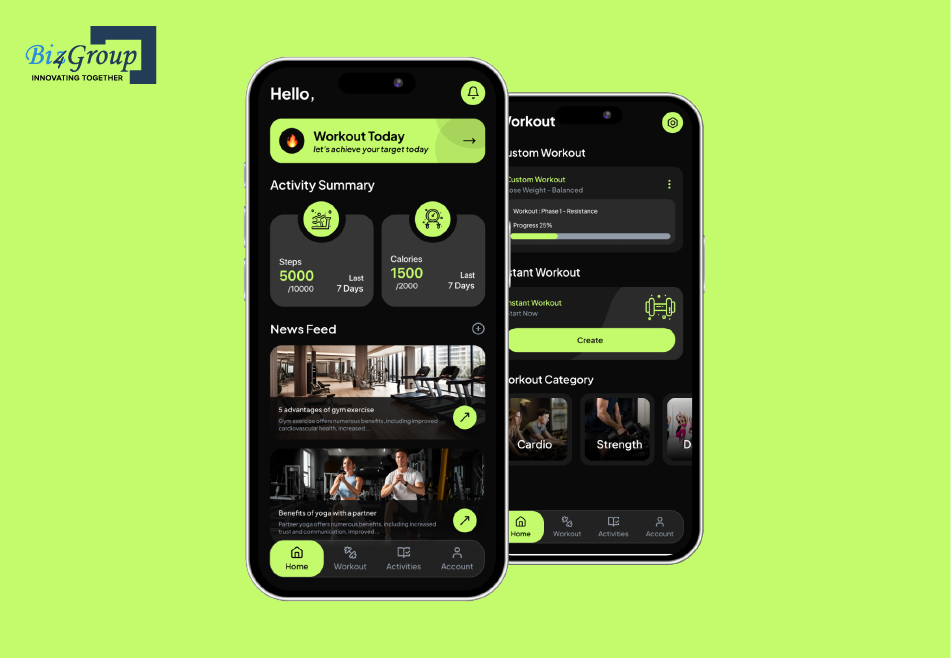
As an experienced AI fitness software development company, we built a full-fledged fitness platform that leverages computer vision and advanced recommendation models to help users assess their bodies and follow tailored, goal-specific workout routines—all through a single, intuitive app.
What we faced:
What we delivered:
With the AI Workout App, we gave them a mirror that talks back with insights.
And for fitness startups? That’s a game-changing value prop in a crowded market.
You can’t improve what you can’t measure.
And in today’s sports world, vague “good job out there” feedback just doesn’t cut it.
Athletes want data. Coaches want precision. AI delivers both.
Here’s how AI is transforming performance and coaching platforms:
Use this if: You're building a solution for elite athletes, training academies, or sports clubs that demand continuous performance analysis at scale.
Gut instinct may land a player once in a while, but talent scouting is evolving. AI is adding objectivity, scale, and predictability to the recruitment game.
Here’s what AI brings to the table:
Use this if: You’re targeting sports academies, pro teams, or recruiting platforms looking to modernize talent evaluation.
Several of these AI-powered sports platforms function similarly to on-demand app development models, delivering personalized experiences instantly based on real-time user needs.
Modern fans don’t just watch the game. They want to be in it.
AI makes this possible by delivering customized, interactive experiences that keep fans coming back—before, during, and after the game.
Here’s how:
Use this if: You want to help sports brands, leagues, or media companies keep fans emotionally invested beyond the scoreboard.
Live sports are unpredictable, which makes streaming and managing events chaotic without the right tools.
AI is changing that by streamlining how sports events are run and experienced in real-time.
Key advantages:
Use this if: You’re building tech for broadcasters, stadiums, or sports event organizers.
With all these types of AI sports apps in play, it’s clear: whether you're in wellness, media, coaching, or big-league betting—AI integration in mobile sports apps isn’t optional anymore. It’s essential.
Whether you're betting on data or coaching with code, we’re the team to bring your vision to life.
Contact NowNow we have the must-have features that make or break an AI sports app, plus the advanced extras that give yours a competitive edge.
Building a flashy UI is great. But if your app doesn’t have the right core features under the hood, it won’t matter how cool it looks. It’ll flop faster than a fake injury in extra time.
Whether you’re launching a betting app, a coaching tool, or a fan engagement platform, some features are non-negotiable. These are the building blocks that define the user experience, and yes, they’re just as important as your AI model.
Here’s a breakdown of essential features you’ll need when you develop an AI sports app, regardless of the niche:
| Feature | Description |
|---|---|
|
User Authentication & Profiles |
Secure logins with OAuth 2.0 or biometric options, allowing for personalized dashboards and role-based access (athlete, coach, admin, fan). |
|
Real-Time Data Syncing |
Ensures live updates across the app (scores, stats, betting odds, player metrics), powered by sockets or streaming APIs. |
|
Interactive Dashboard |
A personalized view showing user-relevant data: workout progress, game predictions, fantasy points, or training schedules. |
|
AI-Driven Recommendations |
Dynamic suggestions for training modules, betting odds, player drafts, or fan content, based on user behavior and historical data. |
|
Push Notifications |
Real-time alerts for scores, injuries, lineup changes, or training feedback, driven by intelligent user triggers, and optimized through smart AI automation services that adapt to user behavior and context. |
|
In-App Chat / Messaging |
Enables communication between users—coaches and players, fans and fantasy groups, or customer support bots. |
|
Multimedia Upload & Analysis |
Allows users to upload images or videos for AI-powered analysis (e.g., form correction, body scanning, or highlight tagging). |
|
Admin Panel / Management Dashboard |
Role-based control for managing content, users, settings, and app analytics, built for scalability and control. |
|
API Integrations |
Seamless integration with third-party services like live sports feeds (SportRadar, ESPN), payment gateways, or wearable devices. |
|
Analytics & Reporting |
Visualized insights for users and admins, including performance trends, predictive outcomes, and engagement metrics. |
These features form the backbone of any reliable, scalable AI sports application. They’re what turn an idea into a working product, and a working product into a fan favorite.
Using computer vision, your app can analyze an athlete’s form in real time, whether it’s a tennis serve, a deadlift, or a sprint.
Instant feedback helps users correct posture, improve performance, and prevent injuries… all without a coach standing next to them.
Let your app simulate match results using historical performance, player health, and game-day data, just like we explain in our complete guide to AI sports predictions app development.
Perfect for betting platforms, fantasy apps, and broadcast companions looking to spice up the pre-game hype.
Integrate natural language processing to power voice-guided feedback or chatbot-driven coaching.
It’s like having a trainer in your pocket, only this one knows your stats better than you do.
Automatically identify key moments (goals, fouls, aces, turnovers) and generate highlight clips on the fly.
Ideal for broadcasters and social media teams who need content faster than a post-game press conference.
Want to keep user data private without sacrificing model performance?
Federated learning lets your AI improve from decentralized data, perfect for fitness apps and training platforms handling sensitive personal metrics.
Build mini-games and AI challenges (e.g., “beat this sprint time” or “perfect your squat form”) that turn workouts or matches into engaging competitions.
It’s habit-building disguised as entertainment.
Imagine pointing your phone at a live match and seeing predicted stats, player bios, or fantasy point updates in real time. AR overlays powered by AI unlock a new level of fan immersion.
These features are what the innovations users expect in 2025, and they’re the reason many sports tech startups are pulling ahead in markets that used to be dominated by legacy brands.
You’ve got the Wishlist. We’ve got the wizards. Let’s bring those features to life the smart way.
Schedule a Free CallUp next: Let’s answer a question every founder wrestles with—should you build, buy, or blend when developing your AI sports app?
Ah, the age-old product dilemma: do you start from the ground up, plug into an existing system, or meet somewhere in the middle?
When it comes to AI sports app development, the decision depends on your goals, timeline, and how unique you want your platform to be.
Here's a side-by-side breakdown to help you figure it out faster than a VAR check.
| Factor | Build from Scratch | Buy / White-Label | Blend (Custom + Off-the-Shelf) |
|---|---|---|---|
|
Speed to Market |
Slower (3–6+ months) |
Fast (weeks) |
Moderate (6–10 weeks) |
|
Upfront Cost |
High |
Low to Moderate |
Moderate |
|
Customization |
Total control |
Limited |
High (modular) |
|
Tech Ownership |
100% yours |
Vendor-controlled |
Partial ownership |
|
Scalability |
Fully scalable to your needs |
Vendor limitations apply |
Flexible scalability |
|
Maintenance |
In-house or outsourced |
Handled by provider |
Shared |
|
Innovation Potential |
Unlimited |
Generic experience |
High, within selected modules |
|
AI Integration |
Tailored AI models and logic |
Pre-set capabilities |
Best of both |
|
Ideal For |
VC-backed startups, sports orgs with niche use cases |
MVPs, budget-restricted teams |
Growth-stage companies, feature-focused startups |
If you're starting from zero, engaging MVP development services can help you validate your product before investing in a full-fledged build.
Whichever route you go, make sure your tech partner understands not just code, but your market, your audience, and your long-term vision.
Now, let’s walk through the step-by-step process to develop an AI sports app, from concept to MVP and beyond.
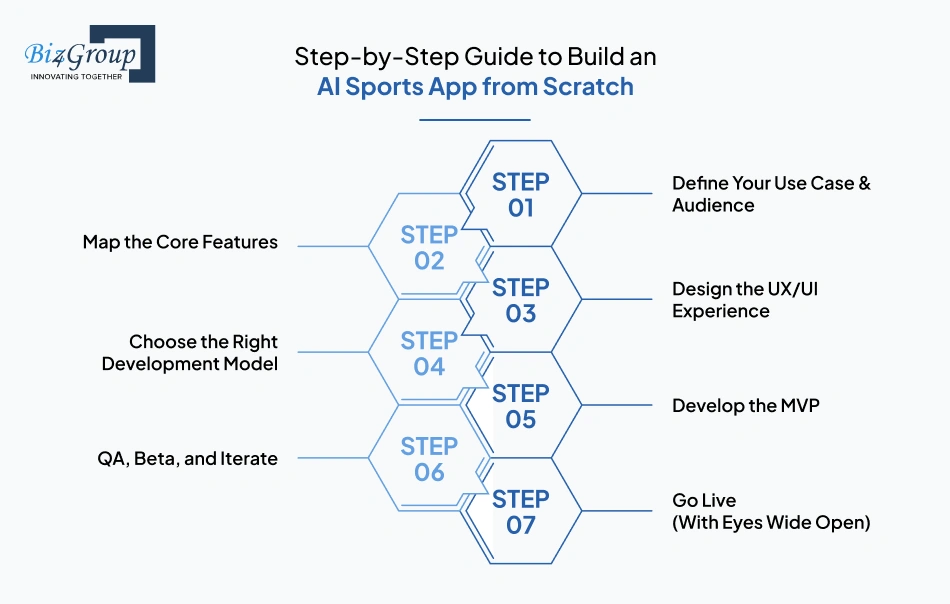
So, you’ve got the idea. The market’s hot. The AI buzz is real.
Now comes the hard part: actually building the thing, without losing your budget, your timeline, or your sanity.
Developing an AI sports app isn’t just about plugging in a few models and shipping an interface. It’s a strategic process that blends product vision, user psychology, real-time data, and just enough AI magic to make everything feel intuitive (but never overwhelming).
Whether you're aiming for a sleek betting app, a performance tracker, or something totally disruptive, here’s your no-fluff, all-action roadmap to make it happen.
Before a single line of code is written, ask yourself:
Who is this app for and what problem does it solve?
This clarity is the difference between building a feature factory and creating a product users need.
Defining these early is crucial and often overlaps with the foundational process of how to build an AI app, which includes identifying key objectives, datasets, and value propositions.
Based on your use case, prioritize the essential features your MVP (Minimum Viable Product) needs.
Focus on what brings real value in version 1.0. Everything else can wait.
Design isn’t just aesthetics... it’s strategy, and working with the right UI/UX design company can make or break your product’s engagement and retention metrics.
Users don’t just want to use your app. They want to enjoy using it.
Now comes the build vs buy vs blend decision you just read about. Depending on your budget and timelines:
Please, don’t try to DIY your AI from day one unless you’ve got a PhD and a backup plan.
This is where things get real. Your dev team builds the front end, back end, database, and AI integration in sprints. If you’re short on talent, consider the option to hire AI developers with domain expertise to accelerate development and avoid costly missteps.
Make sure they:
Weekly demos and testing are your best friends here.
Need help choosing the right team? Here’s a curated list of top MVP development companies in the USA to jumpstart your decision-making.
Once the MVP is built, you’re not done. You’re just getting started.
If possible, bring on a few users early, they’ll catch what your team missed.
Once you’re confident, launch to a wider audience.
Remember, the real MVP is the team that keeps improving post-launch.
Don’t just sit on your product roadmap. Let’s turn that strategy into something users can actually tap on.
Build With UsReady to build something smart, fast, and unforgettable?
Before you jump into code, let’s talk tech stack, because the tools you choose can make or break your AI sports app.
Here’s the truth: even the smartest AI can’t save an app built on a wobbly tech foundation.
If you want your platform to scale, sync real-time data, and deliver buttery-smooth experiences, you need a stack that can take a hit and keep on running.
So, when you build an AI sports app from scratch, here’s what your toolkit should look like:
| Tool | Why It Works |
|---|---|
|
React / Next.js |
Dynamic UIs, fast rendering, SEO-friendly (great for marketing pages) |
|
Flutter / React Native |
Cross-platform mobile development with native performance |
|
Tailwind CSS / SCSS |
Clean, scalable styling for snappy visual design |
|
Chart.js / Recharts / D3.js |
Beautiful, real-time data visualization (performance stats, odds, etc.) |
| Tool | Why It Works |
|---|---|
|
Node.js / Express |
Fast, scalable server-side JavaScript (ideal for real-time apps) |
|
Python / FastAPI |
Best for integrating AI models, handling ML operations |
|
Go / C# |
High-performance modules (e.g., real-time data syncing, admin panels) |
|
Socket.IO / WebSockets |
Enables real-time score updates, betting odds, live chat |
| Tool | Why It Works |
|---|---|
|
MongoDB / PostgreSQL |
Flexible data modeling for users, games, bets, and performance tracking |
|
Redis |
Super-fast caching for real-time updates |
|
AWS S3 / Firebase Storage |
Secure, scalable media storage (videos, analytics, reports) |
| Tool | Use Case |
|---|---|
|
TensorFlow / PyTorch |
Core machine learning workflows |
|
OpenCV / MediaPipe |
Pose estimation, motion tracking, body analysis |
|
OpenAI / Gemini / Custom GPT models |
NLP-driven coaching, chatbots, smart content |
|
3D Look API / Custom Vision Models |
Body measurement and computer vision tasks |
|
Scikit-learn / XGBoost |
Predictive modeling (fantasy scores, match outcomes, training success) |
| Tool | Why It Works |
|---|---|
|
AWS / GCP / Azure |
Reliable cloud hosting with ML model support |
|
Docker / Kubernetes |
App containerization and auto-scaling |
|
CI/CD Pipelines (GitHub Actions, Jenkins) |
Streamlined deployments and updates |
Your tech stack should match your ambition.
You don’t need to use everything above, but you do need to choose tools that can handle real-time data, smart AI logic, and user demand like a pro.
You’ve got smart AI, real-time updates, and users rolling in.
But if your app isn’t secure or legally sound? That launch party might not last long.
When you build an AI sports app from scratch, security and compliance are dealbreakers.
Whether you're handling player health data, processing payments for fantasy leagues, or streaming game content to global users, you need to cover your bases.
Here’s how.
| If your app includes… | Make sure you’re compliant with… |
|---|---|
|
Collecting user data (location, age, gender, preferences) |
GDPR, CCPA |
|
In-app payments or betting transactions |
PCI-DSS, Anti-Money Laundering (AML) laws |
|
Medical/fitness data or biometrics |
HIPAA (USA), GDPR (EU) |
|
Children/teen users under 18 |
COPPA (USA), GDPR-K (EU) |
|
Global user base |
Localized data sovereignty laws (e.g., India’s DPDP, Brazil’s LGPD) |
Security and compliance are ongoing, evolving responsibilities that grow as your user base does.
Now, let’s look at the common challenges in AI sports app development and how to avoid fumbling them on game day.
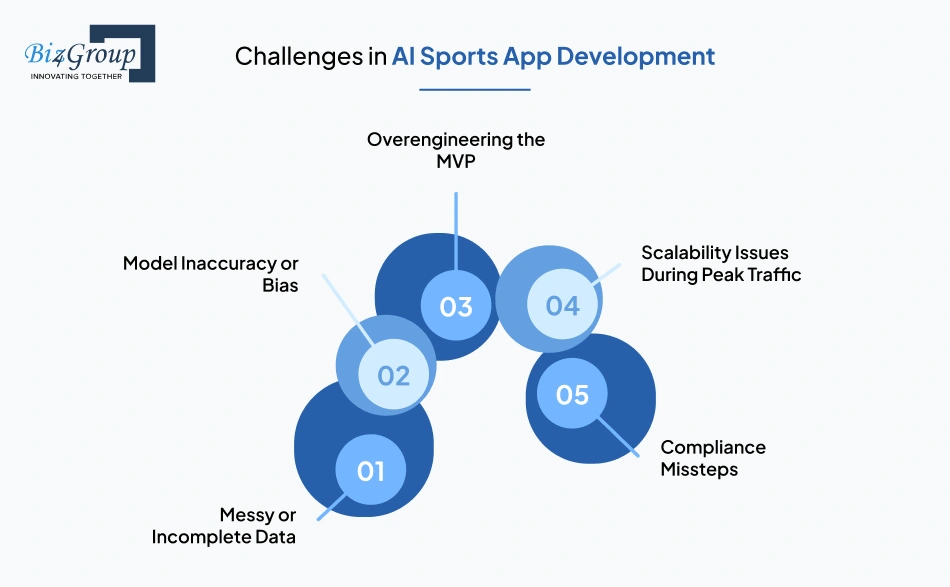
AI in sports apps sounds cutting-edge, and it is.
But behind all the slick dashboards and smart predictions lies a brutal truth: developing an AI-powered sports platform isn’t always smooth sailing.
From data nightmares to ballooning budgets, these are the biggest traps dev teams fall into, and exactly how to avoid them.
AI is only as smart as the data you feed it.
And in sports, data isn’t always clean, complete, or consistent.
The Problem:
How to Fix It:
“Why did the AI recommend benching our top player?”
Sound familiar?
The Problem:
How to Fix It:
AI has a bad habit of making people overbuild.
Spoiler alert: users won’t care about 14 predictive charts if the app crashes when they log in.
The Problem:
How to Fix It:
Your app might work fine during testing, but what about during the Super Bowl or NBA playoffs?
The Problem:
How to Fix It:
A fan uploads a video. An athlete logs injury data. A user places a bet.
Now you’re handling personal, health, and financial data, and regulators are watching.
The Problem:
How to Fix It:
AI isn’t magic. It’s strategy, planning, and relentless iteration.
The teams that win in this space aren’t the ones who throw the most features at the wall. They’re the ones who build smart, scale steadily, and learn from every challenge.
Avoid dev disasters and AI misfires with a team that’s done this before (and lived to tell the tale).
Talk to Our Experts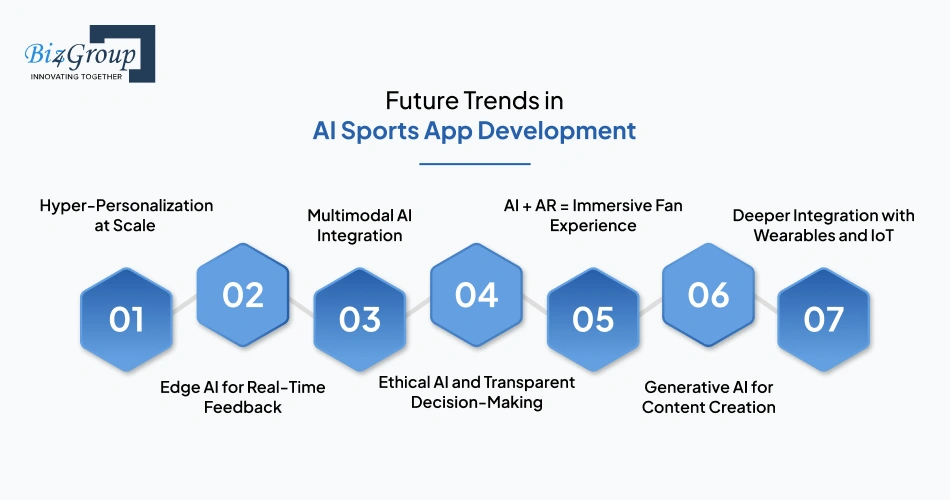
If you think AI in sports is already impressive, buckle up, because we’re still in the warm-up phase.
From smarter personalization to fully immersive fan experiences, the next wave of AI innovation is all about going deeper, faster, and more human.
And if you’re planning to build an AI sports app from scratch, these are the trends you can’t afford to ignore.
Tomorrow’s apps will suggest workouts or stats and anticipate user intent.
No more cloud lag.
Edge computing will allow AI models to run directly on devices (phones, wearables, cameras), enabling:
This makes AI feel... less robotic and more like a coach who's right there with you.
We're moving beyond just text or video.
AI models that process video, audio, sensor data, and text together will unlock powerful use cases:
Users are demanding more clarity from their tech.
“Why did I get this recommendation?” is a question your app will need to answer.
Augmented reality, powered by AI, will reshape how fans engage.
AI won’t just be behind the scenes. It’ll be right in the fan’s hand.
Need a match recap? A training breakdown? A social media caption?
As wearables become more advanced, sports apps will integrate with:
It’s not just about movement anymore. It’s about the entire human system.
The takeaway?
AI sports app development is just getting started.
The platforms that win tomorrow will be the ones that start planning for these innovations today.
Speaking of tomorrow, let’s talk about why Biz4Group is the right tech partner to help you build it.
So you’ve got the idea, the ambition, and now, you need a crew that can actually build the thing.
That’s where we come in.
Biz4Group isn’t your average dev shop. We’re trusted advisors to forward-thinking entrepreneurs and brands who want to lead the game and not play catch-up. We don’t just write code; we architect digital experiences that move fast, scale smart, and look incredible doing it.
And yes, we know how to build AI sports apps that crush it. We are a pretty solid sports betting app development company.
We’re a US-based software development company with 20+ years of deep experience in:
More importantly, we know how to build things that users actually want to use.
We’ve Done It Before (and We’re Still Doing It)
From SportsMEX to fantasy leagues to AI workout trackers, we’ve built AI sports apps that are live, loved, and scaling globally.
We're Tech Agnostic, Not Trend Blind
Need OpenCV, 3D Look, GPT integration, or a custom CV model? We don’t push tools, we pick the right ones for your goals.
Real-Time Is Our Comfort Zone
Live odds? In-game data? Real-time feedback?
We’ve engineered socket-based ecosystems that don’t blink, even during game-day chaos.
You Get a Strategic Partner—Not Just Developers
We don’t ghost you after delivery.
As trusted advisors, we help you evolve your product as your audience grows and the market shifts.
Compliance-Savvy from Day 1
GDPR? HIPAA? AML?
We build with guardrails that keep your product launch-proof and future-proof.
Design + Performance? Yes, Both.
We marry UI/UX with backend brilliance.
Your app won’t just work great. It’ll look and feel premium too.
Here are two more reasons of why you should partner with us:

Sportal is a hybrid web and mobile solution we built to help coaches transform the way they manage players, training schedules, and team performance.
The challenge was clear: the modern sports industry needed a digital-first platform where coaches could track performance, assign training, and communicate seamlessly, all in one place.
Our development team engineered a robust player management ecosystem, integrating communication, task assignment, and advanced reporting into a single intuitive interface. By building a scalable backend and a flexible hybrid app, we ensured Sportal could support teams of all sizes, from grassroots academies to professional setups.
Key Development Highlights:
The Result:
Sportal empowers coaches to focus on performance improvement instead of admin work, providing them with actionable insights, real-time communication, and AI-backed tools to manage entire teams efficiently. It’s proof that Biz4Group knows how to blend sports domain expertise with scalable app development.
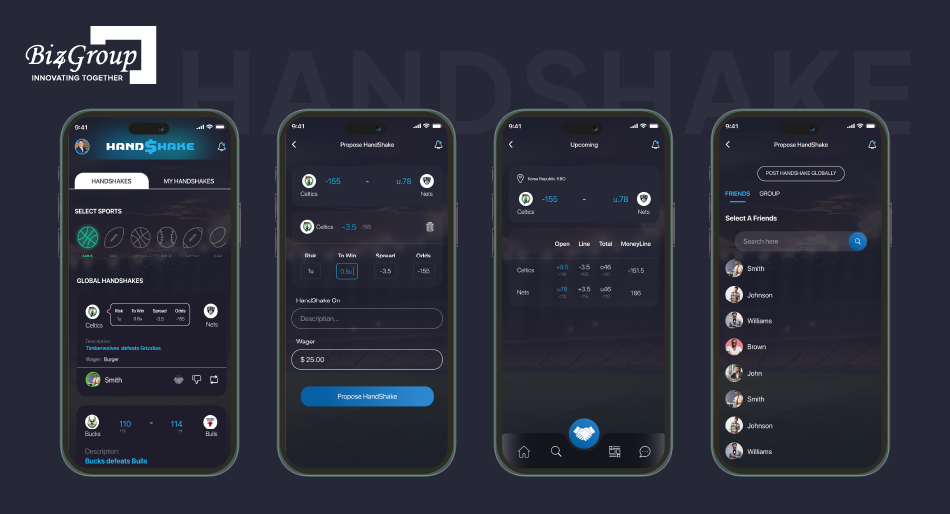
Handshake is a trailblazing sports betting app that merges real-time data with social interaction.
The challenge was to build a platform that could stream live game scores, schedules, and betting opportunities in real time, all while keeping the interface intuitive and engaging for sports fans.
We developed a high-performance mobile app that integrates real-time APIs, AI-driven betting suggestions, and social features like group chat and friend challenges. The platform was designed for scalability, ensuring users experience zero lag even during peak matches. Our team also focused on compliance-ready architecture, keeping security and fairness at the forefront.
Key Development Highlights:
The Result:
Handshake delivers more than just betting; it creates a community-driven experience where users can wager for money, entertainment, or bragging rights. By blending real-time system engineering with AI-driven insights, Biz4Group proved why we’re the best development partner for sports tech businesses looking to scale fast and stand out.
So, basically the truth is that you don’t need just a dev team. You need a team that’s obsessed with innovation, grounded in execution, and allergic to average.
That’s Biz4Group.
Ready to build the next breakout app in sports tech? Let’s chat. No pitches, just possibilities.
Schedule your free consultation now
If there’s one thing the future of sports tech is shouting from the rooftops, it’s this: AI isn’t optional... it’s the edge.
Whether you’re building for fans, coaches, athletes, or fantasy junkies, the right AI integration can transform your app from a simple digital product into a revenue-generating, loyalty-driving, decision-making machine.
From betting to biometrics, performance analysis to personalization, working with a proven AI development company ensures you’re not just chasing trends, but building lasting innovation.
Today’s users want smarter, faster, and more engaging experiences.
And tomorrow? They’ll expect nothing less.
So if you're ready to:
Then it’s time to team up with the people who’ve actually done it, an AI app development company that knows the playbook inside out is your best first move.
Biz4Group is ready when you are.
Time to turn your vision into the next big thing in sports tech.
Let’s Talk.
Costs can vary widely based on your app’s features, AI complexity, target platforms (iOS, Android, web), and region of development. A basic MVP with core AI features might start around $50,000, while advanced apps with real-time data sync, predictive modeling, or AR could go well into six figures. You can also check our breakdown on how much it costs to build an AI sports betting app like Rithmm for detailed insights.
Timelines usually range from 3 to 8 months, depending on the scope. A simple app with limited AI features may be delivered in under 12 weeks, while complex platforms with real-time analytics and integrations often require 6 months or more, including QA, beta testing, and iterations.
Yes, AI can often be integrated into an existing sports app if your current infrastructure is modular and scalable. However, legacy systems may require refactoring or rebuilding certain components to support AI processing efficiently.
It depends on your use case. For performance tracking, you’ll need motion data, biometrics, and historical player stats. For fantasy or betting apps, game results, team performance, and user behavior data are key. Clean, labeled, and diverse datasets will drive better model accuracy.
Yes, many leagues and data providers own the rights to real-time stats and game content. You’ll need to license this data through official APIs or third-party platforms. Unauthorized use can lead to legal disputes, especially if your app is monetized.
Focus on transparency and testing. Use explainable AI models where possible, show confidence scores or reasoning behind predictions, and regularly retrain models with updated data. Always include disclaimers when predictions could influence health or financial decisions.
with Biz4Group today!
Our website require some cookies to function properly. Read our privacy policy to know more.